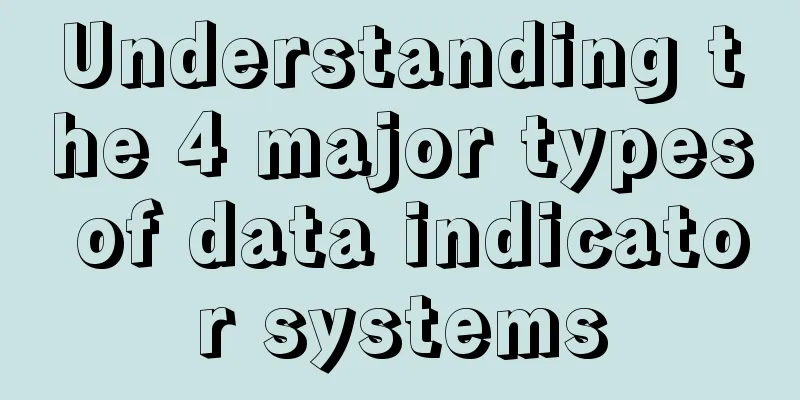Understanding the 4 major types of data indicator systems

Many students asked: "Is there a universal, general method for sorting out indicator systems?" The indicator systems commonly shared online are mostly those like AARRR for the Internet, but the reality is very complicated. Of course, there is a common method, which is to sort out the indicator system based on business logic. In essence, there are four types of data indicator systems, targeting four different business logics. Let's introduce them systematically today. Evaluative “How is the quality of this product?” “Is this activity effective?” “Is this customer group worth serving? This kind of index system that uses data indicators to evaluate whether something is good or bad is called an evaluation index system. Note that you don’t necessarily need to use a data index system to make an evaluation. For example, you can simply look at the sales volume to evaluate the quality of a product. However, looking at only one indicator will cause problems, such as good sales but low profits; good sales but bad reputation. The evaluation indicator system is mainly to solve the problem of bias in single standard evaluation. Therefore, when constructing such an indicator system, the focus is on considering: 1. Reflect the quality from multiple indicators 2. Try not to overlap between indicators 3. Distinguish the importance of each indicator 4. Comparability of various indicators In an evaluation indicator system, the relationship between indicators is often parallel (as shown below): The difficulty of the evaluation indicator system is mainly to consider the comprehensiveness of the problem and the feasibility of indicator data collection. Here we should pay special attention to: the collectability of data indicators. When many students mention evaluation, they will casually mention indicators such as NPS, user satisfaction, and user intention. The question is: 1. How do you plan to collect these indicators? 2. How many real users can be covered using questionnaires? 3. Can the situation be reasonably assessed using other indicators? 4. How to predict the prediction indicator of intention? If these data collection questions are not answered clearly, even if the indicators sound good, they cannot be implemented and will only cause challenges. Process “How are our sales?” “How is our production progress?” “How is our R&D going?” This kind of process-based indicator system uses data indicators to indicate the progress and results of a process. This includes the most familiar transaction process (funnel analysis) model. In fact, as long as it meets the 1. Have a clear endpoint 2. There are several steps 3. For each step with rolling investment resources, a funnel analysis method can be used to build a data indicator system. This is not just a matter of transaction flow or user retention. Production, R&D, and procurement can all be considered in this way. However, in these processes, there is no attenuation at each step, so there is no funnel logic. In these processes, delivery time, quality, and cost are considered (as shown in the figure below). The process-based indicator system is the simplest of the four categories. This is because the process links and end points are very clear. When the goals are clear, the indicator system is easy to sort out. The process-based indicator system is most afraid of data collection, especially process data collection. Many toB industry analyses cannot be carried out because there are too many missing process indicators. Inclusive The inclusive indicator system generally breaks down a large indicator into the sum of several sub-indicators/analysis dimensions. The DuPont analysis method we are familiar with is based on this logic, which breaks down a large indicator. The inclusive indicator system is generally used to diagnose problems. Because the sub-indicators + classification dimensions can pinpoint the problem to a certain business department and action, it is better to find the source of the problem and find a solution. But please note: the diagnostic ability of the inclusive indicator system is based on the premise that the main indicator itself can explain the problem. For example, when using the DuPont analysis method, it is assumed that "profit" is the main problem. If profits cannot explain all the problems, and customer experience, market share, etc. must also be considered, we cannot expect a set of inclusive indicator systems to solve all problems. We need to build a separate indicator system for each problem and provide answers. Influence The reason why it is called impact type is that operational actions are usually superimposed on the normal process to produce additional effects. Normally there is a sales rhythm, and an activity will stimulate sales; normally there is a user retention curve, and a membership reward will stimulate users to stay for a longer period of time. The impact type data indicator system is to make the two points of superposition and additional clear. At this point, the indicators to consider are more complicated 1. A set of data indicators is needed to reflect the normal rhythm of the business 2. A set of data indicators is needed to describe the superposition action itself 3. There needs to be a standard to judge the performance of the business itself 4. Standards are needed to determine additional effects Therefore, the impact-based indicator system will be particularly complex. For example, when making an indicator system for a product promotion activity, it needs to consider 1. Normal sales indicators (quantity of goods sold, number of buyers, amount, profit) 2. Operation of the activity (target number of participants, number of people who meet the target, number of rewards received, and investment in the activity itself) 3. Normal sales trend vs. activity increase There are several possible algorithms for activity increment. For example 1. From the perspective of time, you can distinguish between active and inactive times 2. From the perspective of products, you can distinguish between products with activities and products without activities 3. From the perspective of the crowd, it is possible to distinguish between active and inactive people However, if you examine each method carefully, there are some inadequacies. Because even without an event, the product has its own sales trend (the problem of natural growth rate), and it is difficult to find 100% similar products and groups. Moreover, product promotions may also have an overdraft effect (the fans of the product stock up in advance when the price is low, resulting in a decrease in the subsequent sales). Therefore, when constructing an impact indicator system, it is very troublesome to set reasonable judgment standards, and there will often be arguments. Of course, in principle, a good standard is one that meets business needs, and it is not necessary to consider every effect in detail. However, students should be reminded to be extra cautious when working on this part. Just saying a few indicators casually will cause trouble for subsequent work. Comprehensive application of four types of indicator systems The above four categories can help us sort out our thoughts and deal with problems at work. Because in work and interviews, people who ask questions rarely take the initiative to distinguish: "What is the scenario? What is the business logic?" Instead, they say in general terms: "How do I evaluate this XX? What indicators do I need to look at?" At this point, data analysts must always stay awake. For example, "analyze our product", "analyze our product revision plan", "analyze our product revision effect", and "analyze our product revision feedback activity" are four completely different scenarios, and the supporting indicator systems required are completely different. At the same time, what kind of product it is, you also need to be detailed 1. Transactional products: The main process is transaction, and facilitating transaction is the ultimate goal 2. Content-based products: User behaviors are scattered, there are many forms of monetization, and you need to observe from multiple angles 3. Tool-type products: The functions are fixed, but the breadth and depth of user use vary These are all factors that need to be considered when building an indicator system. That is why I recommend that students do not try to "read and memorize" a few data indicators, but instead master the ability to sort out the data indicator system, so that they can adapt to changes in the future. |
<<: 2025 Consumption Outlook: Rational Consumption, Emotional "Breakthrough"
Recommend
How much money do I need to register Shopee? How much does it cost in the early stage?
If you want to start your own business, many peopl...
Is there still a chance after Shopee’s incubation period? Detailed answer
Merchants who want to join Shopee must complete th...
Wild luxury camping has been popular for two years and remains popular: half rough and half refined!
What is the current status of camping, a trend tha...
What is Amazon visibility? How to improve it?
In the e-commerce platform, we can simply understa...
Latest announcement: WeChat Mini Store begins upgrading to WeChat Mini Store
In the wave of digitalization, the upgrade of WeCh...
After canceling the pre-sale, is Taotian betting on its future on 618?
This 618, whether it is the simplest one or not, i...
How to get image URL on Amazon?
When selling products on Amazon, high-quality prod...
2023 Enterprise WeChat Private Domain Account Maintenance, Anti-Blocking, and Unblocking Skills Strategy
The author of this article introduces WeChat for B...
The Children's Day copy you wanted is here!
The annual Children's Day is coming. Have you ...
If you want to build private domain traffic, you must clarify these 4 issues
In the process of building private domain traffic,...
JD.com has N 618 ads, but only one keyword
This article will take you to find out why "u...
Is eBay the only payment method for PayPal? How do I connect eBay to PayPal?
eBay sells thousands or even millions of items eve...
There is no ceiling for those who understand brand operation
This article focuses on brand operations and share...
What does it mean to abandon a bid on eBay? What should I do if I don't want the item I won?
Merchants who open stores on the eBay platform nee...
How to quickly analyze a marketing case in 6 minutes?
I understand a lot of principles, but they are not...









